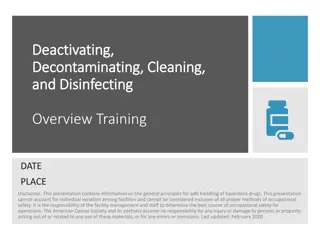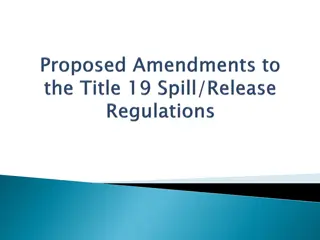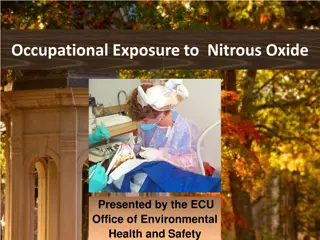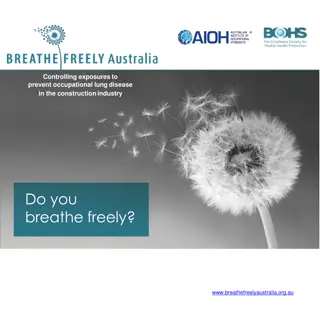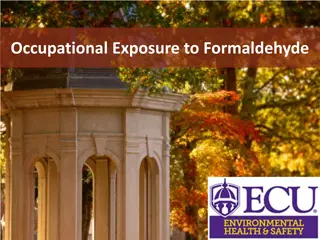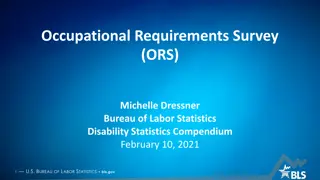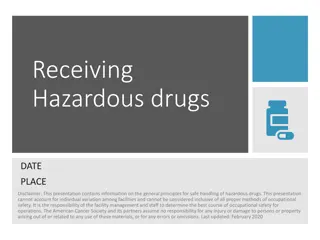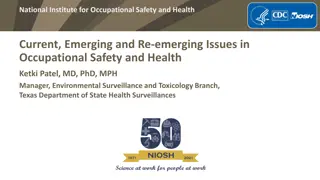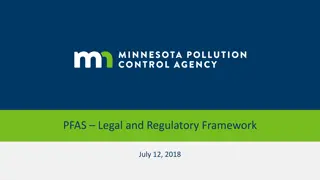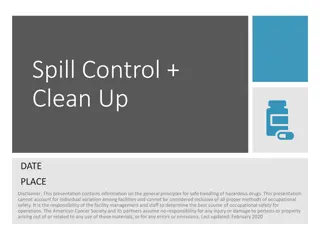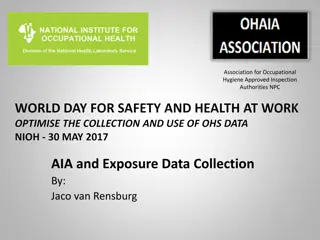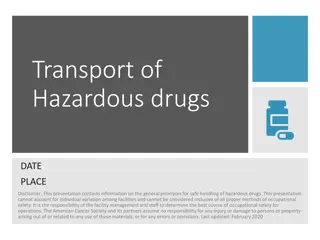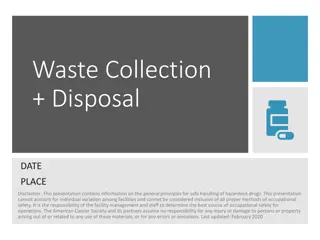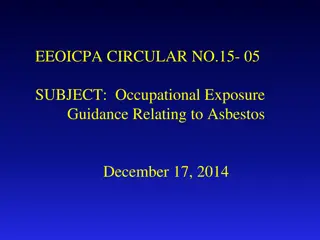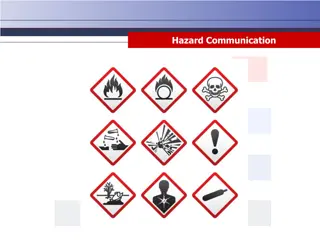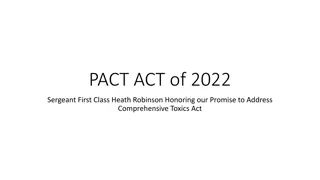Preventing Occupational Exposure to Hazardous Drugs: Module 2 Overview
This training module focuses on preventing occupational exposure to hazardous drugs, covering routes of exposure, hierarchy of controls, recommended procedures, and control measures. Prior review of Module 1 is advised for a comprehensive understanding of the topic.
Download Presentation

Please find below an Image/Link to download the presentation.
The content on the website is provided AS IS for your information and personal use only. It may not be sold, licensed, or shared on other websites without obtaining consent from the author. Download presentation by click this link. If you encounter any issues during the download, it is possible that the publisher has removed the file from their server.
E N D
Presentation Transcript
Preventing Occupational Exposure to Hazardous Drugs Module 2
Please review Module 1 of this training series before proceeding. Before Beginning Module 2 Module 1 includes: An overview of the hazards of certain drugs Personnel and procedures with greatest risk for exposure MIOSHA regulatory requirements 2 Michigan Department of Labor and Economic Opportunity
Identify routes of exposure List the hierarchy of controls Describe recommended procedures for controlling exposure during: Module 2 Training Overview Preparation Administration Disposal Decontamination and spill clean-up Review additional consideration, resources, and references 3 Michigan Department of Labor and Economic Opportunity
Routes of Exposure Absorption skin contact Inhalation aerosolization Ingestion contamination of food or beverages Injection needlesticks 4 Michigan Department of Labor and Economic Opportunity
Hierarchy of Controls Elimination/ Substitution - Eliminates the exposure before it can occur - Requires a physical change to the workplace Engineering Controls - Requires employer/worker to DO something Administrative and Work Practice Controls Personal Protective Equipment 5 Michigan Department of Labor and Economic Opportunity
Elimination and Substitution Professional healthcare providers prescribing hazardous drugs (HD): Consider possible elimination or substitution for less hazardous drugs Form or delivery of the drug (i.e., tablet vs. liquid) Thorough understanding of occupational health hazards of prescribed drugs 6 Michigan Department of Labor and Economic Opportunity
Engineering Controls Examples of controls*: Externally vented Biologic Safety Cabinet (BSC) Compounding Aseptic Containment Isolator (CACI) Closed system transfer device (CSTD) Advantages: Isolates and Contains the hazard Independent of the worker 7 Michigan Department of Labor and Economic Opportunity
Engineering Controls Control Location Type of Ventilation Special Features Nonsterile compounding: external vent preferred Ventilated device (i.e. biological safety cabinet, compounding aseptic isolator) Inside a compounding room Containment (primary control) Sterile compounding: external vent required Externally vented through high-efficiency particulate air (HEPA) filter Compounding room (secondary control) Physically separated from other rooms Negative pressure Compounding and administering Not a substitute for a primary control when compounding Closed system device (supplemental) None 8 Michigan Department of Labor and Economic Opportunity
Examples of Controls Compounding Aseptic Isolator Biological Safety Cabinet 9 Michigan Department of Labor and Economic Opportunity
Administrative Controls Examples: Written policies and procedures Hazardous Drug List* Education, training and competency* Medical surveillance Alternative duty around pregnancy - may be discriminatory * Required by MIOSHA Hazard Communication Standard and USP <800> 10 Michigan Department of Labor and Economic Opportunity
Work Practice Controls Examples: Label HDs with appropriate hazard warnings Transport HDs in sealed bags Inspect HD containers for leaks Wash hands after removing PPE Avoid touching unnecessary items with contaminated gloves Avoid wearing PPE outside drug handling areas Avoid spiking and priming IV tubing (without a closed system) Discard used IV equipment intact 11 Michigan Department of Labor and Economic Opportunity
Personal Protective Equipment (PPE): Gloves Tested with hazardous drugs Donning Powder-free Inner glove worn under gown cuff Latex, nitrile, neoprene* Outer glove worn over gown cuff Wear two pair Doffing Remove gloves one at a time Turn gloves inside out while removing Keep contaminated surface from touching uncontaminated *USP<800> requires chemo gloves to meet ASTM standard D6978 (or its successor) 12 Michigan Department of Labor and Economic Opportunity
Personal Protective Equipment (PPE): Gowns Disposable Single-use Polyethylene or vinyl-coated Remove and discard gown: When visibly contaminated Tested with hazardous drugs At the end of handling activities When leaving the handling area Cuffs and back closure Do not hang up and re-use 13 Michigan Department of Labor and Economic Opportunity
Other Personal Protective Equipment (PPE): Face/Eye/Respiratory Eye protection When splashing is possible Respirator For aerosols and spills Fitted (tight seal) respirator Appropriate to the hazard N95 rated (filtering particulate respirator) Powered Air Purifying Respirator (PAPR) 14 Michigan Department of Labor and Economic Opportunity
USP <800> Requirements for PPE Appropriate PPE MUST be worn when handling HDs during: Receipt Storage Transport Compounding (sterile and non-sterile) Administration Deactivation/decontamination, cleaning, and disinfecting 15 Michigan Department of Labor and Economic Opportunity
Recommended Precautions: Administration Form/Route of Administration Double Gloves Protective Gown Respiratory Protection Engineering Control Eye Protection Intact tablet or capsule Tablet or capsule (manipulated) Oral Liquid No. Single glove No No No N/A Yes, if not done in control device No If inhalation potential Yes, if inhalation potential Yes, if inhalation potential Yes Yes Yes Yes Yes Yes Yes No N/A Yes, if liquid could splash Yes, if liquid could splash Yes, if liquid could splash Yes Topical Drug Yes Yes N/A Yes. Sharps protection Recommend CSTD N/A Sub Q/M/ injection Yes Yes Intravenous solution Irrigation Yes Yes Yes Yes Inhalation Yes Yes Yes Yes Yes 16 Michigan Department of Labor and Economic Opportunity
Hazardous Drug Spills Spills happen Sprays Dropped vials and bags Punctured IV bags Broken totes from wholesalers Patient unit/infusion area Spill consequences Personnel/patient exposure Environmental contamination 17 Michigan Department of Labor and Economic Opportunity
Cleaning Contaminated Surfaces - Summary Cleaning Step Purpose Agents As listed in the HD labeling or if no specific information available, sodium hypochlorite or other Environmental Protection Agency (EPA)- registered oxidizer Render compound inert or inactive Deactivation Remove inactivated residue Sterile alcohol, sterile water, peroxide, or sodium hypochlorite Decontamination Remove organic and inorganic material Cleaning Germicidal detergent and sterile water Destroy microorganisms Sterile alcohol or other EPA-registered disinfectant appropriate for use Disinfection Resource: U.S. Pharmacopeial Convention (USP <800>), Table 5. Summary of Cleaning Steps 18 Michigan Department of Labor and Economic Opportunity
Recommended Contents of a Spill Kit Sufficient supplies to absorb one liter PPE to protect worker Two pair chemo-tested gloves Utility gloves Cover-all or gown and shoe covers Face shield Absorbent plastic-backed sheets or spill control pillows Disposable towels Two sealable, thick plastic waste bags Disposable scoop Puncture-resistant container 19 Michigan Department of Labor and Economic Opportunity
Assess the Spill Evaluate: Consider: Drug spilled Glass debris Surface(s) affected Liquid Floor? Powder/Dust Countertop? Exposure or potential for exposure Furniture? Personal protective needed Size of spill Need for additional assistance* Presence of vapors 20 Michigan Department of Labor and Economic Opportunity
Spill Notification Restricted area vs. public Isolation of area (vapors) Need for evacuation Internal spill response team? External HazMat team? 21 Michigan Department of Labor and Economic Opportunity
Step 1: Cover (contain) the spill Liquid: Absorbent pads Cloths/paper Spill control pillows Powder: Dampen pads, cloths or paper 22 Michigan Department of Labor and Economic Opportunity
Step 2: Don PPE Scoop debris Do NOT use hands! 23 Michigan Department of Labor and Economic Opportunity
Step 3: Remove residue Consider surface material Refer to facility policy for methods to manage spills on carpet/upholstery 24 Michigan Department of Labor and Economic Opportunity
Post-Spill Decontamination & Deactivation Oxidizing agent 2% sodium hypochlorite + detergent Effective for bleomycin, daunorubicin, etoposide, fluorouracil, mitomycin, vinblastine, vincristine 30-second contact time Neutralizer 1% sodium thiosulfate Effective for cyclophosphamide, ifosfamide, melphalan, methotrexate 30-second contact time Rinse with water 25 Michigan Department of Labor and Economic Opportunity
Contain Clean-up Materials Place in Disposal Bag #1: Place in Disposal Bag #2: Absorbent pads Bag #1 with its contents Papers/ cloths Shoe covers Spill control pillows Outer gloves Other disposables Face shield Sharps in rigid container Respirator (if disposable) 26 Michigan Department of Labor and Economic Opportunity
Finally Place in Bag #2 Gown Inner gloves Close Bag #2 Dispose of Bag #2 in designated container Wash hands with soap and water 27 Michigan Department of Labor and Economic Opportunity
Document the Spill Recommend creating a designated spill report form: Who, what, where, when Participants in clean up Steps taken to clean the spill Follow-up 28 Michigan Department of Labor and Economic Opportunity
Managing Acute Exposure Type of Exposure Immediate Care Follow Up Remove contaminated clothing/PPE. Wash affected area with soap and water. Consult DSD for drug-specific instructions. Flush eye(s) with water or isotonic eye wash for 15 minutes. Consult SDS for drug-specific instructions. Move to area with fresh air. Consult DSD for drug-specific instructions. Do not induce vomiting. Consult SDS for drug-specific instructions. Skin exposure Report to employee health professional or emergency department, based on symptoms. Eye exposure Complete report of employee injury/exposure. Inhalation exposure Follow policy related to workers compensation Ingestion 29 Michigan Department of Labor and Economic Opportunity
MIOSHA Resources: Standards and Compliance Part 92 and 430 Hazard Communication Part 431 Hazardous Work in Laboratories Part 33 and Part 433 Personal Protective Equipment Part 451 Respiratory Protection Part 474 Sanitation Part 554 Bloodborne Infectious Diseases Recording and Reporting of Occupational Injuries and Illnesses 30 Michigan Department of Labor and Economic Opportunity
MIOSHA Resources: Consultation and Training Preventing Exposure to Hazardous Drugs Training Module 1 Overview Preventing Exposure to Hazardous Drugs Training Module 2 Staff Fact Sheet: Preventing Exposure to Hazardous Drugs Hazard Communication Sample Plan (pdf) Personal Protective Equipment Guide (SP-16) (doc) Respiratory Protection Program (SP-05) (doc) Bloodborne Sample Exposure Control Plan (CET 5230) (doc) 31 Michigan Department of Labor and Economic Opportunity
Federal Resources Centers for Disease Control and Prevention: NIOSH Hazardous Drugs webpage OSHA: Hazardous Drugs Website Hazardous Drugs eTool Technical Manual Section VI: Chapter 2: Controlling Occupational Exposure To Hazardous Drugs 32 Michigan Department of Labor and Economic Opportunity
Questions? Michigan Occupational Safety and Health Administration (MIOSHA) Consultation, Education and Training (CET) Division MIOSHA/ CET Main Line: 517-284-7720 Michigan.gov/MIOSHA




